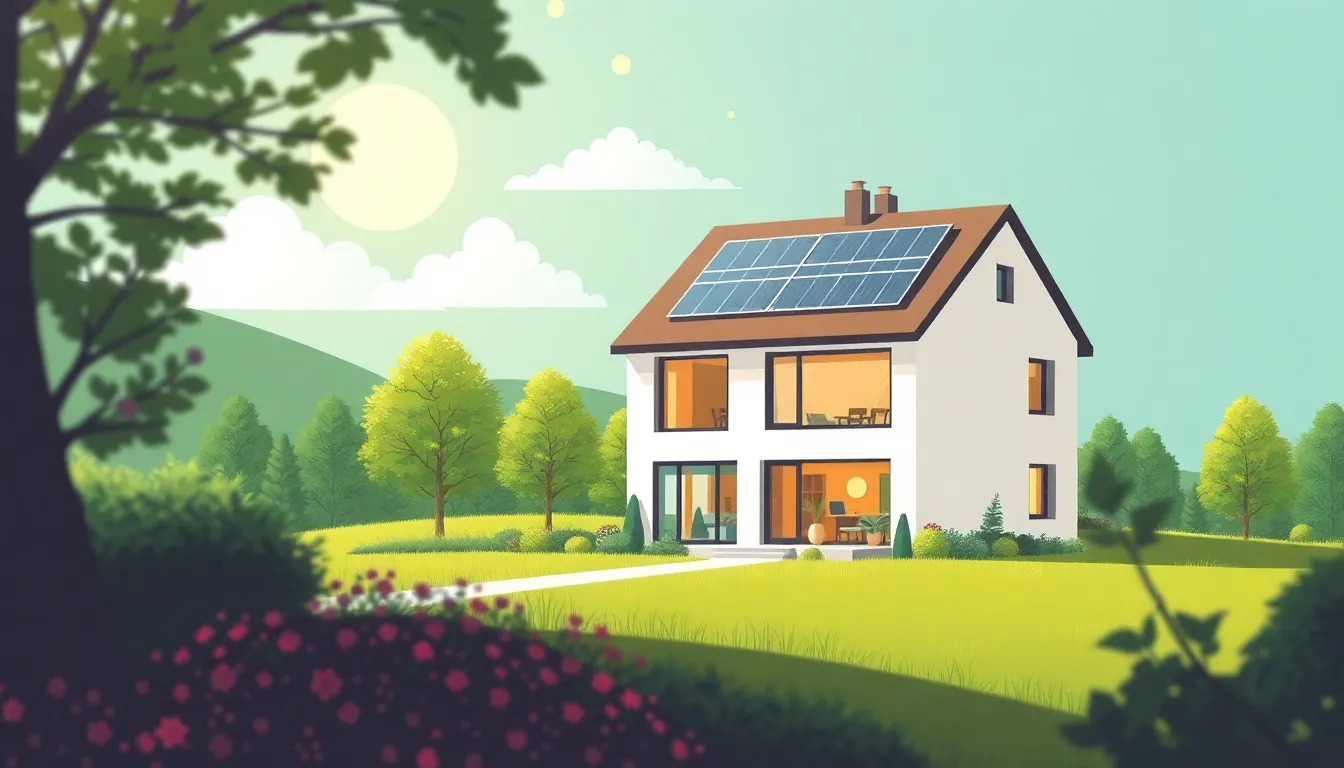In a world where energy bills seem to rise faster than a cat chasing a laser pointer, energy-efficient homes are the superheroes we didn’t know we needed. They swoop in to save the day, slashing costs while keeping the environment smiling. Imagine a home that not only hugs your wallet but also gives Mother Nature a warm, fuzzy feeling.
Table of Contents
ToggleWhat Are Energy-Efficient Homes?
Energy-efficient homes are designed to minimize energy consumption while providing optimal comfort. These structures incorporate advanced insulation, energy-efficient windows, and energy-saving appliances. Reducing the amount of energy needed for heating, cooling, and lighting significantly lowers utility bills.
Construction materials play a crucial role in energy efficiency. Many energy-efficient homes use sustainable materials like bamboo, recycled steel, and rammed earth. These options not only improve energy performance but also contribute to environmental conservation.
Homeowners can benefit from renewable energy sources as well. Solar panels and wind turbines offer alternatives to conventional energy sources, decreasing dependence on fossil fuels. In addition to lowering energy costs, these systems may qualify owners for tax incentives and rebates.
Building orientation, landscaping, and architectural design enhance energy efficiency as well. Properly positioned windows allow for maximum natural light, reducing the need for artificial lighting during the day. Strategically placed trees and shrubs provide shade, decreasing cooling demands in warmer months.
Energy-efficient homes often meet specific certifications and standards. Programs like ENERGY STAR ensure homes achieve recognized energy conservation benchmarks. Adopting these standards aids homeowners in identifying properties that contribute positively to their energy usage and the environment.
By focusing on energy-saving features, homeowners improve both their financial situation and overall quality of life. Energy-efficient homes represent a progressive approach to building. Choosing this path fosters sustainability and promotes energy awareness.
Benefits of Energy-Efficient Homes

Energy-efficient homes deliver significant advantages for homeowners and the environment. These benefits include cost savings and reduced ecological footprints, making them a smart choice in any housing market.
Cost Savings
Energy-efficient homes lead to lower utility bills through reduced energy consumption. Homeowners can save up to 30 percent on energy costs compared to traditional homes, depending on selected features. Energy-efficient appliances also consume less electricity and water, creating substantial savings over time. Many homeowners enjoy the additional benefit of potential tax incentives when they install solar panels or make energy-efficient upgrades, further decreasing upfront costs. With proper insulation and efficient windows, heating and cooling expenses drop, which makes for a comfortable living space throughout the year.
Environmental Impact
Energy-efficient homes significantly contribute to environmental sustainability. By lowering energy consumption, they reduce greenhouse gas emissions and dependence on fossil fuels. The implementation of renewable energy sources, like solar panels, provides clean energy, which supports the transition to a sustainable future. Sustainable materials such as bamboo and recycled steel reduce waste and enable responsible resource use. Landscaping choices that enhance energy efficiency also contribute to biodiversity preservation. Homes that achieve certifications like ENERGY STAR promote awareness and use of eco-friendly practices, empowering more homeowners to embrace energy conservation.
Key Features of Energy-Efficient Homes
Energy-efficient homes incorporate various features designed to minimize energy consumption while maximizing comfort. These aspects contribute not only to cost savings but also to environmental sustainability.
Insulation and Sealing
Effective insulation and sealing are fundamental for energy efficiency. Quality insulation materials significantly reduce heat transfer, keeping homes comfortable year-round. Tight sealing around doors and windows eliminates drafts, enhancing energy retention. This combination minimizes the need for heating and cooling, which lowers utility costs. Building codes often require specific R-values for insulation, ensuring homes meet energy efficiency standards. Homeowners can expect reductions in energy bills of up to 30 percent when proper insulation and sealing are prioritized.
Energy-Efficient Appliances
Using energy-efficient appliances plays a crucial role in conserving energy. These appliances are designed to operate using less electricity while maintaining high performance. They often feature ENERGY STAR ratings, which indicate their efficiency level. Examples include refrigerators, washing machines, and dishwashers that consume significantly less energy than standard models. Homeowners can reduce their energy bills considerably by choosing energy-efficient options, as these devices account for a significant portion of household energy use. Upgrading to modern appliances not only lowers operational costs but also contributes to reduced greenhouse gas emissions.
Renewable Energy Sources
Integrating renewable energy sources enhances a home’s sustainability. Solar panels and wind turbines provide clean energy, reducing reliance on fossil fuels. These installations can lead to substantial savings on energy bills over time. Homeowners often benefit from tax incentives when investing in renewable energy technologies, making them more appealing. In many cases, solar energy can cover a substantial percentage of a home’s energy needs. By adopting renewable energy sources, homeowners contribute to a more sustainable future while securing long-term financial benefits.
Designing an Energy-Efficient Home
Creating energy-efficient homes involves careful planning and design choices that focus on minimizing energy use while maximizing comfort. Homeowners can significantly benefit from strategic decisions made during the building process.
Orientation and Layout
Orientation directly influences a home’s energy efficiency. Proper positioning of windows maximizes solar gain during the winter while minimizing heat during the summer. A well-thought-out layout can enhance airflow and natural lighting, reducing the reliance on artificial lighting and cooling systems. Positioning outdoor spaces can create shade during peak sunlight hours, helping to lower cooling demands. By considering local climate and geography, builders can optimize the home’s design for energy performance.
Sustainable Materials
Sustainable materials make a substantial impact on the efficiency of energy-efficient homes. Bamboo offers a durable yet renewable alternative to traditional wood, while recycled steel reduces waste and energy consumption during production. Insulation made from recycled products also enhances energy performance, providing superior thermal resistance. Choosing materials that promote indoor air quality, such as low-VOC paints and sealants, leads to healthier living environments. Using these materials not only supports environmental conservation but also aligns with energy-efficient standards that homeowners can trust.
Energy-efficient homes are more than just a trend; they’re a crucial step towards a sustainable future. By embracing innovative designs and renewable energy sources, homeowners can significantly reduce their energy consumption and costs. This not only enhances their financial well-being but also contributes to a healthier planet.
As awareness of climate change grows, the demand for energy-efficient homes will likely increase. Homeowners who invest in these properties not only enjoy immediate benefits but also play a vital role in promoting environmental conservation. The combination of advanced technology and sustainable practices in home construction ensures that energy-efficient homes are a wise choice for anyone looking to make a positive impact.


